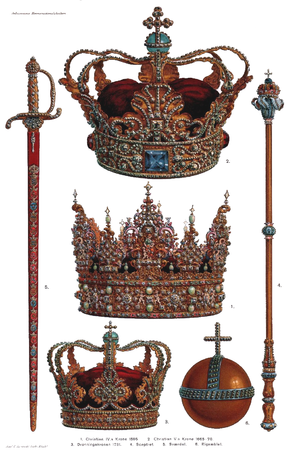Danish Crown Regalia
They further include King Christian IV's diamond; pearl- and gold-embroidered saddles; objects carved from ivory and rock-crystal; lapidary pieces of precious stones, and brooches in the form of fantastic animals.
[1] During the time of the elective monarchs, the clergy and nobility placed the crown on the king's head at the coronation ceremony.
For the anointing of Christian V, a new crown was made along with the Throne Chair of Denmark of narwhal teeth (supposedly the mythical unicorn's horn) and three silver lions, the latter created by Ferdinand Küblich (1664–1687).
This was inspired by the biblical description of King Solomon's throne, which was said to be composed of unicorn's horn and gold and guarded by twelve golden lions.
The lions were formerly also displayed in Parliament during the annual opening session, but this tradition was discontinued almost 100 years ago.
The crown was fashioned by Dirich Fyring (1580-1603) at Odense assisted by the Nuremberg goldsmith Corvinianus Saur during the years 1595-1596 for the coronation of Christian IV.
At the center of each of the larger points is an enameled allegorical figure of one of the king's ruling functions and virtues.
The point above the back of the king's neck bears the traditional image of Charity as a mother suckling her child.
The six smaller points each bears a star-like design in triangular and square table diamonds with a large pear shaped pearl at its top.
[9] The circlet of the crown is divided in four by two large sapphires, a flat one that can be traced back to Frederick I at the forehead of the wearer (presumably a gift to his father, Christian I, from Galeazzo Maria Sforza, the Duke of Milan in 1474) and a thicker one at the back of the head and by a spinel at one side and a garnet at the other.
The front acanthus leaf is decorated with a large table cut diamond with Christian V's royal cypher visible behind it.
The scabbard has a diamond-studded Chape, is covered in red velvet and is decorated with the coats of arms of different parts of the realm.
The ampulla, used to contain the anointing oil, is a gold cylinder and its lid enameled with a variety of flowers and studded with table cut diamonds made by an unknown Copenhagen goldsmith for the coronation of Frederick III in 1648.




